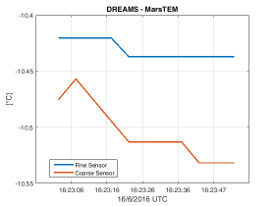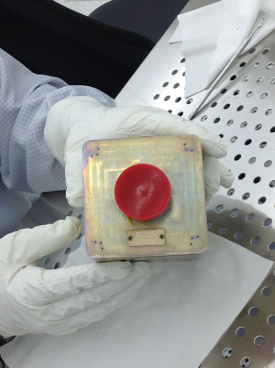Schiaparelli delivers mid-term report
22 June 2016
With just over half of the journey to Mars completed, the Schiaparelli entry, descent and landing module has carried out its mid-cruise checkout. DREAMS and DECA have called home to report that they are in good health.
.jpg) |
| Interior of Schiaparelli with DREAMS sensors labelled. Credit: ESA/ATG medialab |
The Schiaparelli module, launched with the ExoMars Trace Gas Orbiter on 14 March, is a demonstrator to test key technologies in preparation for ESA’s contributions to subsequent missions to Mars.
On 19 October, the module will enter the Martian atmosphere at an altitude of about 121 km and a speed of 21,000 km/s. Within six minutes it will have decelerated and landed – at a site on Meridiani Planum.
Now, en route to the Red Planet, scientists are taking advantage of the cruise phase to check the status of the payload.
During the mid-cruise checkout of DREAMS that was run on 16 and 17 June, the sensors measured the environmental conditions inside the ExoMars entry descent and landing module, both in the warm compartment where the electronics are housed and in the central area of the module where the sensors are situated.
The measurements are all perfectly in line with what is expected, according to DREAMS Principal Investigator, Francesca Esposito, from INAF - Osservatorio Astronomico di Capodimonte, Naples, Italy. "During this check-out we have looked at how the DREAMS sensors are responding inside the module as well as making some science measurements," she explains. "These tests are used to monitor the health of the sensors and to compare their behaviour in space with that in the laboratory. We also use these tests to set the zero point for some of our sensors – this is important for when we are operating on Mars because we need to be sure that our sensors are all well calibrated."
This recent checkout was the second since launch. On 8 and 9 April, the near-Earth commissioning tests were carried out. At that time, the scientists responsible for DREAMS were present at the European Space Operations Centre for the real-time commanding of the Schiaparelli payload.
 |
| MarsTem measurements during mid-cruise checkout. Credit: ESA/Roscosmos/ExoMars/DREAMS/INAF |
In contrast, this latest checkout was run autonomously onboard the module, following a sequence of commands that had been uploaded during the week. "Once again, DREAMS has behaved beautifully and this bodes very well for operations on the surface," says Francesca. "We have some more checkouts planned during the next few weeks and months so that we can monitor the health of DREAMS and keep an eye on any drift in the sensors. These checks are essential as they will allow us to have confidence in the behaviour of our sensors before they start taking measurements on the surface of Mars."
DREAMS will operate on the Red Planet for a few days after landing, powered by its batteries. During this time it will monitor local weather conditions at the landing site on Meridiani Planum, gathering measurements of temperature, humidity, pressure, dust opacity, wind speed, and wind direction. The final timeline for the sequence of measurements to be made on the surface will be uploaded to DREAMS after the last checkout and before separation.
DREAMS will also make the first measurements of atmospheric electric fields at the planet’s surface that, combined with measurements of the retrieved dust opacity, will provide new insights into the role of electric forces on dust lifting – the trigger for dust storms.
 |
| DECA with lens cap on. Credit: ESA |
The small descent camera, DECA, was also tested during this mid-cruise checkout. DECA, which is the flight spare of the Herschel visual monitoring camera, will take 15 images at 1.5 s intervals shortly after the front shield of Schiaparelli has been jettisoned, from an altitude of a few kilometres.
During these recent tests DECA cycled through its image acquisition sequence to obtain 15 pictures of the dark interior of the module. These are used to check the health of the camera and to calibrate it.
"DECA operates autonomously while taking the 15 images during descent," explains Detlef Koschny, Team Leader of DECA, from ESA's Scientific Support Office at the European Space Research and Technology Centre. "These checkout tests are very important as they allow us to monitor the status of the camera during flight and to calibrate it so that we can make the most of the 15 images that we will get."
In addition to DREAMS and DECA, Schiaparelli carries the COMARS+ package to characterise the heat shield response during descent; supports an investigation into atmospheric studies with AMELIA, using engineering sensors; and carries a retroreflector, called INRRI.




